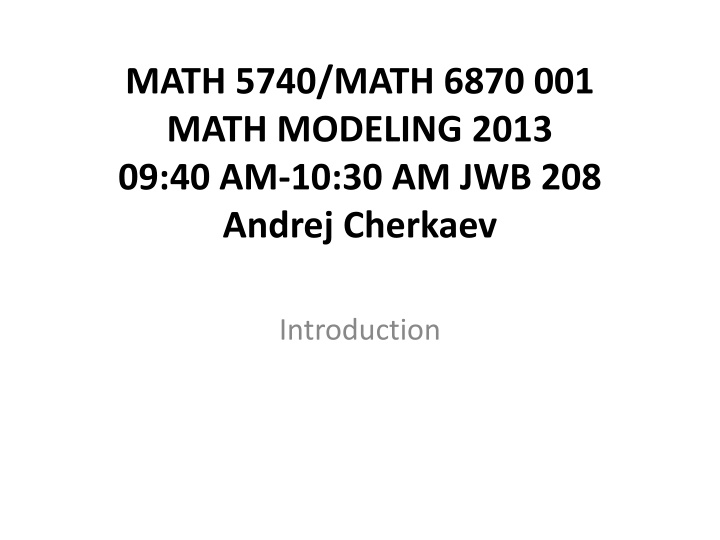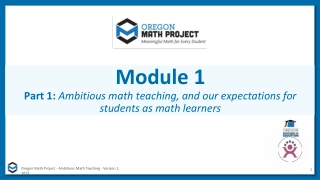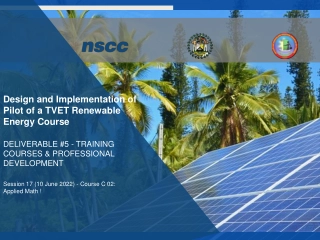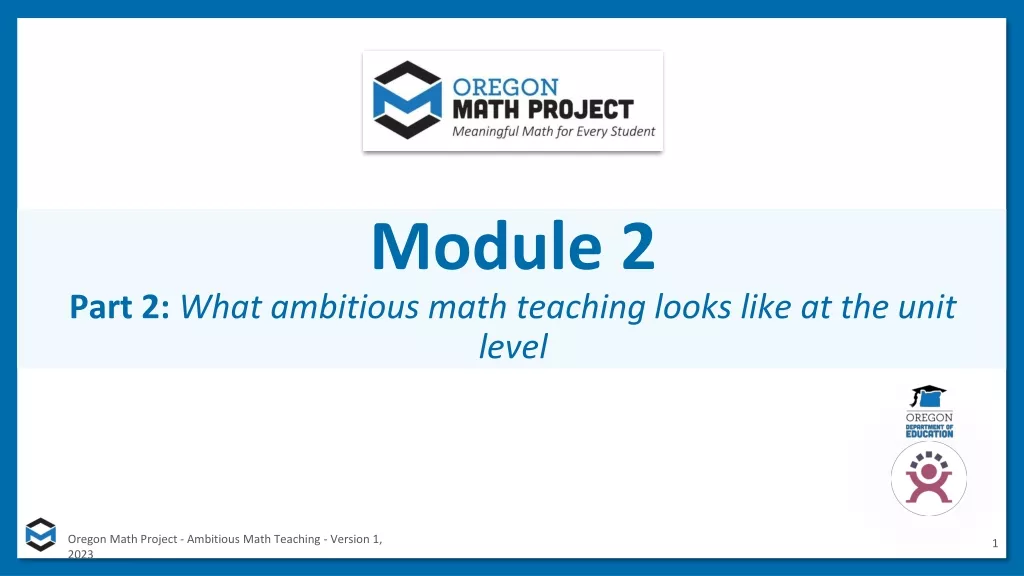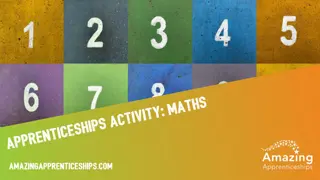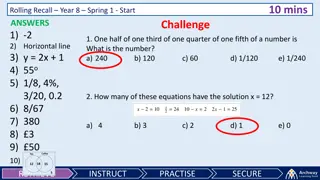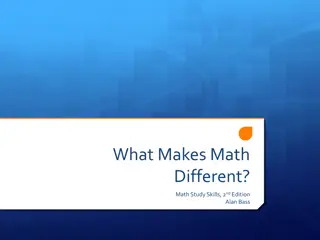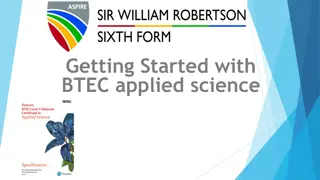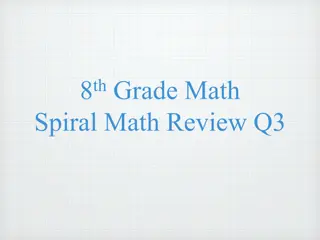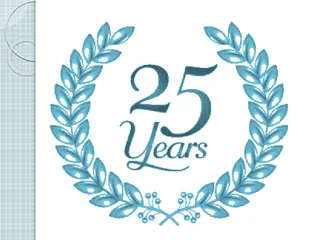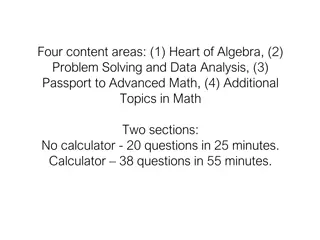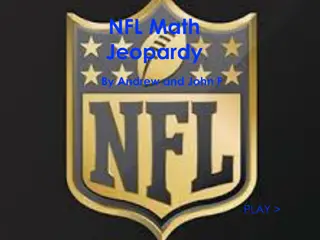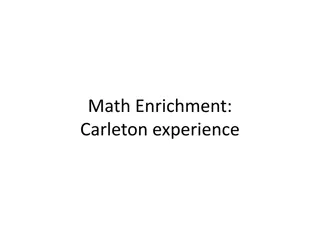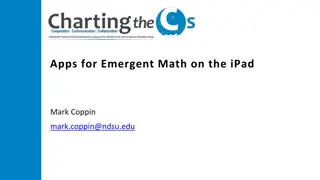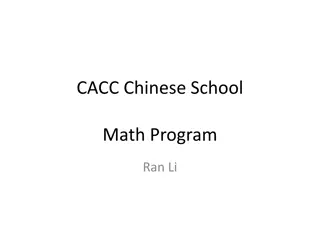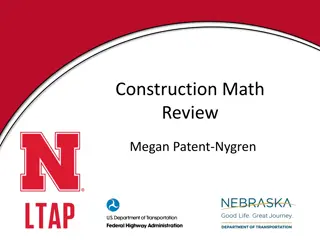Introduction to Applied Math Concepts
A mathematical model is a key tool in various disciplines like physics, biology, economics, and more. Explore the components of applied math, modeling principles, and the significance of models in understanding the world around us. Delve into the history of modeling and its evolution over time to become a central aspect of scientific inquiry and problem-solving across different fields.
Uploaded on Mar 08, 2025 | 2 Views
Download Presentation

Please find below an Image/Link to download the presentation.
The content on the website is provided AS IS for your information and personal use only. It may not be sold, licensed, or shared on other websites without obtaining consent from the author.If you encounter any issues during the download, it is possible that the publisher has removed the file from their server.
You are allowed to download the files provided on this website for personal or commercial use, subject to the condition that they are used lawfully. All files are the property of their respective owners.
The content on the website is provided AS IS for your information and personal use only. It may not be sold, licensed, or shared on other websites without obtaining consent from the author.
E N D
Presentation Transcript
MATH 5740/MATH 6870 001 MATH MODELING 2013 09:40 AM-10:30 AM JWB 208 Andrej Cherkaev Introduction
Components of applied math Differential equations Math Modeling Numerical Methods Applied math Data: Statistics approx Optimization Physics, or biologogy, or chemisty, or ..
Modeling is naming and understanding of the world phenomena The term "fractal" was first used by Polish- French-American mathematician Benoit Mandelbrot in 1975.
Models and reality Theory attracts practice as the magnet attracts iron. Gauss The applied math studies problems that are inspired by a nature phenomenon or a social need. We live in the world of models: Great models: Universe, Nuclear Physics, Evolution, Social organization determine our life forcing our judgment, decisions, and feelings Paradigms arrive in the form of new models: atoms, Neo- Darwinism, fractals, democracy. Models are reference points: New ideas are placed in the framework of exiting models
Definition from Wiki A mathematical model uses mathematical language to describe a system. Mathematical models are used in the natural sciences and engineering disciplines (such as physics, biology, earth science, meteorology, and engineering) and in the social sciences (such as economics, psychology, sociology and political science).. The process of developing a mathematical model is termed 'mathematical modelling' (also modeling).
Galilei, Galileo (1564 - 1642): [The universe] cannot be read until we have learnt the language and become familiar with the characters in which it is written. It is written in mathematical language, and the letters are triangles, circles and other geometrical figures, without which means it is humanly impossible to comprehend a single word. Opere Il Saggiatore p. 171. Thought_experiment http://en.wikipedia.org/wiki/Thought_experiment
Features of math models Goals: descriptive or design/optimization (natural or engineering model). Range of applicability (Ideal gas, Black matter, optimization) Validation: Mental experiment vs. real experiment. Galileo. Results: Numerical or analytic. Simulation models. Predictability: Curve fitting vs. equation solving. (based on a priori principles or empirical). The good model should to a degree predict the behavior of a system in a new environment. Mathematical tools Geometry, Equation solving, ODE, PDE, calculis of variations, numerical methods, game theory, probability, statistics, optimization and control theory, etc. Creativity Mathematics is made of 50% formulas, 50% proofs, and 50% imagination.
Model is an intentionally distorted system description that emphasizes desirable features Everything should be made as simple as possible, but not simpler. A. Einstein Model is not unique Bridge: for traffic model a piece of road For flight navigation model an obstacle For vibration model an unbreakable elastic structure For strength model an elastic-plastic structure For bungle jumping -- a base. For an artist a shape. The Millau Viaduct
Models intentionally distort reality No one needs a geographical map in the scale 1:1
Syllabus (Wish list) Introduction. Principles of modeling. Great Model of the Universe. From observations and assumptions to equations. How to split the class in several working groups Growth and interaction of species. Population dynamics. Epidemic spread. Model of population dynamics. Model of epidemic disease and vaccination. PDE Model of population dynamics. Wave models. Traffic: shock waves, stabilization factors. Simulation of a traffic jam. Domino, slinky, and similar discrete waves Modeling of conflicts: Games- Best strategy, minimax. Cooperative game - How to share fairly. Evolutionary games - Models of social behavior. Models with graphs Models with shapes. Lattice models of complicated structures. Metamaterials
Principles of modeling in the syllabus Simplification. To what extend? Combination of discrete and continuum descriptions. Examples of continuum models: Population dynamics, Traffic waves. Examples of discrete description: Domino train, breakable chains, division of the class. Waves and repeated sequences of events. -Wave of damage, traffic waves, evolution dynamics. Stability and catastrophes -- Domino, multiple equilibria system, breakable chains. Multiscale approach, models for different scales: Evolution dynamics, decease spread. Descriptive modeling vs Design and Optimization. Formalization of ``humanitarian'' concepts.
Organization of the class work For the project work the class will be divided into groups of tree A presenter will orally present the group s work, the report will be written. The group get a grade for the project. The groups will be formed for each project, the roles will be reassigned so that each student will be researcher and presenter. Problem: (one week) Write an algorithm for dividing the class into groups of three for each project. During the semester, each student should work with all class mates. Next time, bring in your ideas.
Models of the Universe a. Turtles all the way down. b. Ptolemy: Earth in the center, planets move with constant speed, circular orbits, and epicycles: http://www.pbs.org/wgbh/nova/ancient/ancient-computer.html c. Copernicus 1473-1543: Sun in the center, planets move with constant speed, circular orbits, and epicycles. http://en.wikipedia.org/wiki/Turtles_all_the_way_down http://en.wikipedia.org/wiki/Geocentric_model http://en.wikipedia.org/wiki/Copernican_heliocentrism
Keplersmodel, Newton law Johannes Kepler published his first two laws in 1609, the third in 1619 (1) The orbits are ellipses, with focal points 1 and 2 for the first planet and 1 and 3 for the second planet. The Sun is placed in focal point 1. (2) (2) The two shaded sectors A1 and A2 have the same surface area and the time for planet 1 to cover segment A1 is equal to the time to cover segment A2. (3) (3) The total orbit times for planet 1 and planet 2 have a ratio a1^3/2 : a2^3/2. Newton gravity law explained all three Kepler s laws but left open the question of how the gravity force acts. Einstein s general relativity explains the nature of the gravity force
History of modeling of the Universe (HW 1) Write a short essay (< 3 pages) about models of Universe: Turtles all the way down Ptolemy (Kla dios Ptolema os), Nicolaus Copernicus Tycho Brahe and Johannes Kepler, Isaac Newton (gravity law) Albert Einstein (general relativity) Big Bang theory Characterize the models as empirical, data fitting, equation solving, general-principle-based and comment on motivation for the improvement/development. thought and physical experiments. What question were asked? Use Internet, Wiki, or any other available sources http://astro.unl.edu/naap/ssm/animations/ptolemaic.swf
